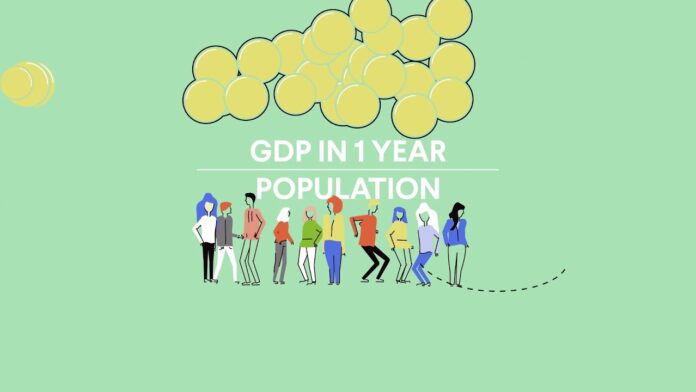The COVID-19 pandemic has not only affected the health and well-being of people around the world, but it has also had a significant impact on the global economy. Businesses have shut down, unemployment rates have skyrocketed, and many countries have seen their GDPs plummet. However, with the rollout of vaccines and various economic recovery initiatives, there is hope for the global economy to bounce back from this crisis.
In this blog post, we will explore the current state of the global economy, the impact of the pandemic, the efforts being made towards economic recovery, as well as the challenges that lie ahead. We will also discuss the future outlook for the global economy and what it means for businesses and individuals around the world.
Overview of the global economy pre-pandemic
Before the COVID-19 pandemic hit, the global economy was showing signs of steady growth. In 2019, the global GDP grew by 2.9%, with emerging and developing economies leading the way. The United States, China, and Japan were the top three contributors to the global GDP, with the US alone accounting for nearly 25% of the world’s total GDP.
The global trade volume was also on an upward trend, with the value of merchandise exports reaching $18.89 trillion in 2019. Consumer spending was also rising, particularly in emerging markets, thanks to an increase in middle-class populations and higher disposable incomes.
Overall, the global economy seemed to be in a stable position, with most major countries experiencing healthy growth rates. However, all of this changed when the pandemic struck.
Impact of the pandemic on the global economy

The COVID-19 pandemic brought the global economy to a grinding halt. With countries going into lockdown and businesses closing their doors, the GDP took a massive hit. According to the International Monetary Fund (IMF), the global economy contracted by 3.5% in 2020, representing the worst economic downturn since the Great Depression.
The impact of the pandemic on the global economy was felt across all industries. The travel and tourism sector, for example, suffered a huge blow as borders were closed and people were advised to stay at home. In 2019, this industry contributed $8.9 trillion to the global GDP, but in 2020, it is estimated that it only contributed $4.7 trillion.
Another significant impact of the pandemic was the rise in unemployment rates. As businesses struggled to stay afloat, they were forced to lay off employees, resulting in millions of job losses around the world. The International Labour Organization (ILO) estimates that the pandemic caused the equivalent of 255 million full-time jobs in 2020.
Furthermore, supply chains were disrupted, leading to shortages of essential goods and an increase in prices. This impacted both producers and consumers, with many businesses facing supply chain challenges and consumers experiencing higher costs for everyday items.
Initiatives taken for global economic recovery
In response to the economic crisis brought on by the pandemic, governments and international organizations have implemented various initiatives to stimulate economic growth and aid in the recovery process.
Fiscal stimulus packages
One of the main initiatives has been the implementation of fiscal stimulus packages by governments around the world. These measures involve government spending to boost demand and support struggling businesses and individuals. For example, the US government passed the CARES Act, providing direct payments to individuals and families, enhanced unemployment benefits, and loans for small businesses.
According to the IMF, governments globally have allocated over $14 trillion towards fiscal stimulus measures as of February 2021. While these efforts have helped soften the blow of the pandemic on the economy, they have also led to a sharp increase in public debt levels.
Monetary policies
Central banks have also played a crucial role in the recovery process through monetary policies. These include measures such as lowering interest rates, providing liquidity to financial markets, and purchasing government securities. These actions help to keep borrowing costs low and provide support for businesses and individuals.
For example, the US Federal Reserve lowered its benchmark interest rate to near-zero and initiated a bond-buying program to inject liquidity into financial markets. The European Central Bank also introduced a pandemic emergency purchase program, purchasing government and corporate bonds to support the economy.
Debt relief for developing countries
Developing countries have been severely affected by the pandemic, with limited resources to mitigate its economic impact. To aid these countries, the G20 group of nations, together with the IMF and World Bank, launched the Debt Service Suspension Initiative (DSSI) in May 2020. This initiative allows eligible countries to suspend debt payments to official creditors until June 2021.
The G20 has also agreed to extend the DSSI up to December 2021 and is considering further extensions depending on the evolution of the crisis. This debt relief has provided much-needed breathing room for developing countries to direct their resources towards fighting the pandemic and stimulating economic recovery.
Challenges faced in the recovery process

Despite the various initiatives being taken for global economic recovery, there are several challenges that need to be addressed.
Uneven distribution of vaccines
One major challenge is the unequal distribution of vaccines around the world. While some developed countries have managed to secure enough doses to vaccinate their entire population, many developing countries are struggling to acquire even a small fraction of what they need.
This disparity in vaccine access could lead to a prolonged pandemic, hindering the recovery of the global economy. The World Health Organization (WHO) estimates that the global economy could lose up to $9.2 trillion if low-income countries do not have access to vaccines.
Rising public debt levels
As mentioned earlier, fiscal stimulus packages have led to a significant increase in public debt levels. This high level of debt could become a hindrance to economic recovery in the long run. As countries struggle to repay their debts, it could lead to higher interest rates, inflation, and potentially even a debt crisis.
Furthermore, some developing countries have taken on more debt during the pandemic to fund their own stimulus packages, making them vulnerable to default. This could have ripple effects on the global economy, affecting both developed and developing countries.
Slow recovery of certain industries
While some industries have seen a rebound in demand as lockdowns ease and vaccines are rolled out, others are still struggling. For example, the aviation industry is expected to take years to recover fully, as international travel continues to be restricted. This slow recovery of certain industries could have a knock-on effect on their suppliers and other related businesses, further delaying economic recovery.
Future outlook for the global economy
Despite the challenges that lie ahead, there are reasons to be optimistic about the future of the global economy.
Accelerated digitization
The pandemic has forced businesses to adapt to a digital world quickly. Many companies have shifted to remote work, and consumers have turned to e-commerce for their shopping needs. This accelerated digitization has opened up new opportunities for businesses and could lead to increased efficiency and productivity in the long run.
Stronger global cooperation
The pandemic has highlighted the need for global cooperation and coordination to tackle a crisis of this scale. With initiatives such as the COVAX program aiming to ensure fair access to vaccines around the world, there is hope for stronger global collaboration in the future. This could lead to more effective responses to future crises, benefiting the global economy.
Aided by technology and innovation
Technology and innovation have played a significant role in helping businesses survive during the pandemic. With the rise of remote work, video conferencing, and online shopping, we have seen how technology can keep businesses and economies afloat during a crisis. As we move towards recovery, technology and innovation will continue to play a crucial role in driving economic growth.
Conclusion
The global economy has faced unprecedented challenges due to the COVID-19 pandemic. However, with various initiatives being taken for economic recovery and the potential for future growth, there is hope for a rebound. It is essential for countries to continue working together to ensure fair distribution of vaccines and address the challenges that lie ahead. With the lessons learned from this crisis, the global economy can emerge stronger and more resilient in the face of any future challenges.









